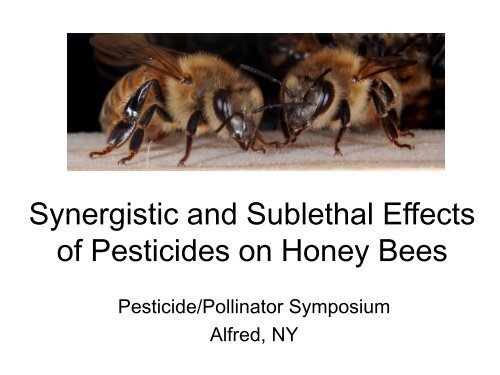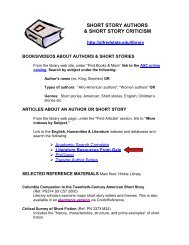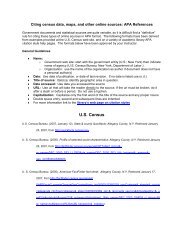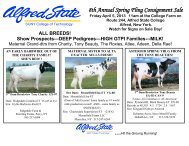Synergistic and Sublethal Effects of Pesticides on Honey Bees
Synergistic and Sublethal Effects of Pesticides on Honey Bees
Synergistic and Sublethal Effects of Pesticides on Honey Bees
You also want an ePaper? Increase the reach of your titles
YUMPU automatically turns print PDFs into web optimized ePapers that Google loves.
<str<strong>on</strong>g>Synergistic</str<strong>on</strong>g> <str<strong>on</strong>g>and</str<strong>on</strong>g> <str<strong>on</strong>g>Sublethal</str<strong>on</strong>g> <str<strong>on</strong>g>Effects</str<strong>on</strong>g><br />
<str<strong>on</strong>g>of</str<strong>on</strong>g> <str<strong>on</strong>g>Pesticides</str<strong>on</strong>g> <strong>on</strong> H<strong>on</strong>ey <strong>Bees</strong><br />
Pesticide/Pollinator Symposium<br />
Alfred, NY
PSU; Pesticide<br />
Investigating Group<br />
PSU; Cox-Foster Lab<br />
Roger Sim<strong>on</strong>ds <str<strong>on</strong>g>and</str<strong>on</strong>g><br />
staff<br />
USDA-AMS Nati<strong>on</strong>al<br />
Science Laboratory<br />
Pesticide Database<br />
Program (PDP)<br />
CCD working team
Exposure to <str<strong>on</strong>g>Pesticides</str<strong>on</strong>g>
Samples Analyzed 2007-’08<br />
• > 900 samples<br />
• From<br />
– CCD study<br />
– Apple orchard study<br />
– Migratory study<br />
– Beekeeper submitted samples<br />
• Cost-sharing program
H<strong>on</strong>ey <strong>Bees</strong> - Excellent Indicator<br />
<str<strong>on</strong>g>of</str<strong>on</strong>g> Envir<strong>on</strong>mental <str<strong>on</strong>g>Pesticides</str<strong>on</strong>g><br />
Acephate<br />
Acetamiprid<br />
Aldicarb sulf<strong>on</strong>e<br />
Aldicarb sulfoxide<br />
Allethrin<br />
Amicarbaz<strong>on</strong>e<br />
Amitraz (2,4-DMA)<br />
Amitraz (2,4-DMPF)<br />
Atrazine<br />
Azinophos-methyl<br />
Azoxystrobin<br />
Bendi ocarb<br />
Bifenthrin<br />
Boscalid<br />
Captan<br />
Carbaryl<br />
Carbary l (1-Naphthol)<br />
Carbendazim<br />
Carb<str<strong>on</strong>g>of</str<strong>on</strong>g>uran , 3-hydroxy<br />
Carfentraz<strong>on</strong>e<br />
Chlorfenapyr<br />
Chlorothal<strong>on</strong>il<br />
Chlorpyrifos<br />
Coumaphos<br />
Coumaphos -Chlorfer<strong>on</strong>e<br />
Coumaphos ox<strong>on</strong><br />
Cyfluthrin<br />
Cyhalothr in (total)<br />
Cype rmethrin<br />
Cyprodi nil<br />
Deltamethrin<br />
Diazin<strong>on</strong><br />
Dic<str<strong>on</strong>g>of</str<strong>on</strong>g>ol<br />
Difenoc<strong>on</strong>azole<br />
Diflubenzur<strong>on</strong><br />
Dimethomorph<br />
Diphenylamine<br />
Endos ulfan 1<br />
Endos ulfan 2<br />
Endos ulfan sulfate<br />
Esfenval erate<br />
Etoxazole<br />
Fenbuc<strong>on</strong>azole<br />
Fenhexamid<br />
Fenpropath rin<br />
Fluva linate<br />
Heptac hlor<br />
Hexachlorobenzene<br />
Imida cloprid<br />
Imida cloprid olefin<br />
Imida cloprid, 5-hydroxy<br />
Indoxacarb<br />
Malathi<strong>on</strong><br />
Methidathi<strong>on</strong><br />
Methoxyfeno zide<br />
Methyl par athi<strong>on</strong><br />
Metolachlor<br />
Metribuzin<br />
Myclobuta nil<br />
Norfluraz<strong>on</strong><br />
Oxamyl<br />
Oxyfluorfen<br />
p,p' -DDE<br />
Pendi methalin<br />
Permethrin<br />
Phosmet<br />
Pyraclostrobin<br />
Pyrethrins<br />
Pyrimethanil<br />
Quintozene (PCNB)<br />
Sethoxydim<br />
Simazine<br />
Tebuc<strong>on</strong>azole<br />
Tebufenozide<br />
Tebuthiur<strong>on</strong><br />
Tetramethrin<br />
Thiabendazole<br />
Thiacloprid<br />
Tribufos<br />
Trifloxystrobin<br />
Trifluralin<br />
Vinclozolin
Multiresidue Pesticide Analysis <strong>on</strong> US Wax,<br />
Pollen <str<strong>on</strong>g>and</str<strong>on</strong>g> <strong>Bees</strong> Samples 2007-08<br />
• Very few samples lacked detecti<strong>on</strong>s<br />
• Found 121 different pesticides <str<strong>on</strong>g>and</str<strong>on</strong>g> metabolites<br />
pyrethroids, organophosphates, carbamates, ne<strong>on</strong>icotinoids<br />
insect growth regulators, organochlorines, chlorinated cyclodienes,<br />
‣20 fungicides, 12 herbicides, 2 acaricides, 1 synergist,<br />
‣At least 14 <str<strong>on</strong>g>of</str<strong>on</strong>g> these are systemic pesticides<br />
• On average 6 different pesticides per pollen sample<br />
- Up to 31 in a single sample
Selected <str<strong>on</strong>g>Pesticides</str<strong>on</strong>g> f<strong>on</strong>d in WAX, POLLEN <str<strong>on</strong>g>and</str<strong>on</strong>g> BEES<br />
Pesticide or<br />
Metabolite<br />
Class<br />
LOD<br />
Samples<br />
Analyzed<br />
Total<br />
Detecti<strong>on</strong>s<br />
% <str<strong>on</strong>g>of</str<strong>on</strong>g><br />
Samples<br />
Mean<br />
(ppb)<br />
SEM<br />
(ppb)<br />
Lowest<br />
Value<br />
Highest<br />
Value<br />
LD50<br />
(ppb)<br />
Carbaryl<br />
PS<br />
CARB 5 836 44 5.3 170.2 9.9 4.5 1010.0 10500<br />
Coumaphos OP 1 887 668 75.3 1454.6 174.8 1.0 91900.0 46300<br />
Fluvalina te PYR 1 887 749 84.4 2947.6 330.7 1.1 204000.0 15860<br />
Imidacloprid NEO 2 836 14 1.7 77.5 5.9 2.4 646.0 280<br />
Imidacloprid<br />
olefin NEO 25 836 2 0.2 597.0 2.1 554.0 640.0 280<br />
Imidacloprid,<br />
5-hydroxy NEO 25 836 2 0.2 151.0 0.0 150.0 152.0 280<br />
Chlorpyrifos OP 0.1 886 396 44.7 40.1 4.0 0.1 890.0 1220<br />
Chlorothal<strong>on</strong>il FUNG 1 797 316 39.6 1860.4 286.3 1.0 98900.0 1110000
Selected <str<strong>on</strong>g>Pesticides</str<strong>on</strong>g> f<strong>on</strong>d in WAX, POLLEN <str<strong>on</strong>g>and</str<strong>on</strong>g> BEES<br />
Pesticide or<br />
Metabolite<br />
Class<br />
LOD<br />
Samples<br />
Analyzed<br />
Total<br />
Detecti<strong>on</strong>s<br />
% <str<strong>on</strong>g>of</str<strong>on</strong>g><br />
Samples<br />
Mean<br />
(ppb)<br />
SEM<br />
(ppb)<br />
Lowest<br />
Value<br />
Highest<br />
Value<br />
LD50<br />
(ppb)<br />
Carbaryl<br />
PS<br />
CARB 5 836 44 5.3 170.2 9.9 4.5 1010.0 10500<br />
Coumaphos OP 1 887 668 75.3 1454.6 174.8 1.0 91900.0 46300<br />
Fluvalina te PYR 1 887 749 84.4 2947.6 330.7 1.1 204000.0 15860<br />
Imidacloprid NEO 2 836 14 1.7 77.5 5.9 2.4 646.0 280<br />
Imidacloprid<br />
olefin NEO 25 836 2 0.2 597.0 2.1 554.0 640.0 280<br />
Imidacloprid,<br />
5-hydroxy NEO 25 836 2 0.2 151.0 0.0 150.0 152.0 280<br />
Chlorpyrifos OP 0.1 886 396 44.7 40.1 4.0 0.1 890.0 1220<br />
Chlorothal<strong>on</strong>il FUNG 1 797 316 39.6 1860.4 286.3 1.0 98900.0 1110000
Selected <str<strong>on</strong>g>Pesticides</str<strong>on</strong>g> f<strong>on</strong>d in WAX, POLLEN <str<strong>on</strong>g>and</str<strong>on</strong>g> BEES<br />
Pesticide or<br />
Metabolite<br />
Class<br />
LOD<br />
Samples<br />
Analyzed<br />
Total<br />
Detecti<strong>on</strong>s<br />
% <str<strong>on</strong>g>of</str<strong>on</strong>g><br />
Samples<br />
Mean<br />
(ppb)<br />
SEM<br />
(ppb)<br />
Lowest<br />
Value<br />
Highest<br />
Value<br />
LD50<br />
(ppb)<br />
Carbaryl<br />
PS<br />
CARB 5 836 44 5.3 170.2 9.9 4.5 1010.0 10500<br />
Coumaphos OP 1 887 668 75.3 1454.6 174.8 1.0 91900.0 46300<br />
Fluvalina te PYR 1 887 749 84.4 2947.6 330.7 1.1 204000.0 15860<br />
Imidacloprid NEO 2 836 14 1.7 77.5 5.9 2.4 646.0 280<br />
Imidacloprid<br />
olefin NEO 25 836 2 0.2 597.0 2.1 554.0 640.0 280<br />
Imidacloprid,<br />
5-hydroxy NEO 25 836 2 0.2 151.0 0.0 150.0 152.0 280<br />
Chlorpyrifos OP 0.1 886 396 44.7 40.1 4.0 0.1 890.0 1220<br />
Chlorothal<strong>on</strong>il FUNG 1 797 316 39.6 1860.4 286.3 1.0 98900.0 1110000
Selected <str<strong>on</strong>g>Pesticides</str<strong>on</strong>g> f<strong>on</strong>d in WAX, POLLEN <str<strong>on</strong>g>and</str<strong>on</strong>g> BEES<br />
Pesticide or<br />
Metabolite<br />
Class<br />
LOD<br />
Samples<br />
Analyzed<br />
Total<br />
Detecti<strong>on</strong>s<br />
% <str<strong>on</strong>g>of</str<strong>on</strong>g><br />
Samples<br />
Mean<br />
(ppb)<br />
SEM<br />
(ppb)<br />
Lowest<br />
Value<br />
Highest<br />
Value<br />
LD50<br />
(ppb)<br />
Carbaryl<br />
PS<br />
CARB 5 836 44 5.3 170.2 9.9 4.5 1010.0 10500<br />
Coumaphos OP 1 887 668 75.3 1454.6 174.8 1.0 91900.0 46300<br />
Fluvalina te PYR 1 887 749 84.4 2947.6 330.7 1.1 204000.0 15860<br />
Imidacloprid NEO 2 836 14 1.7 77.5 5.9 2.4 646.0 280<br />
Imidacloprid<br />
olefin NEO 25 836 2 0.2 597.0 2.1 554.0 640.0 280<br />
Imidacloprid,<br />
5-hydroxy NEO 25 836 2 0.2 151.0 0.0 150.0 152.0 280<br />
Chlorpyrifos OP 0.1 886 396 44.7 40.1 4.0 0.1 890.0 1220<br />
Chlorothal<strong>on</strong>il FUNG 1 797 316 39.6 1860.4 286.3 1.0 98900.0 1110000
Selected <str<strong>on</strong>g>Pesticides</str<strong>on</strong>g> f<strong>on</strong>d in WAX, POLLEN <str<strong>on</strong>g>and</str<strong>on</strong>g> BEES<br />
Pesticide or<br />
Metabolite<br />
Class<br />
LOD<br />
Samples<br />
Analyzed<br />
Total<br />
Detecti<strong>on</strong>s<br />
% <str<strong>on</strong>g>of</str<strong>on</strong>g><br />
Samples<br />
Mean<br />
(ppb)<br />
SEM<br />
(ppb)<br />
Lowest<br />
Value<br />
Highest<br />
Value<br />
LD50<br />
(ppb)<br />
Carbaryl<br />
PS<br />
CARB 5 836 44 5.3 170.2 9.9 4.5 1010.0 10500<br />
Coumaphos OP 1 887 668 75.3 1454.6 174.8 1.0 91900.0 46300<br />
Fluvalina te PYR 1 887 749 84.4 2947.6 330.7 1.1 204000.0 15860<br />
Imidacloprid NEO 2 836 14 1.7 77.5 5.9 2.4 646.0 280<br />
Imidacloprid<br />
olefin NEO 25 836 2 0.2 597.0 2.1 554.0 640.0 280<br />
Imidacloprid,<br />
5-hydroxy NEO 25 836 2 0.2 151.0 0.0 150.0 152.0 280<br />
Chlorpyrifos OP 0.1 886 396 44.7 40.1 4.0 0.1 890.0 1220<br />
Chlorothal<strong>on</strong>il FUNG 1 797 316 39.6 1860.4 286.3 1.0 98900.0 1110000
Outcomes <str<strong>on</strong>g>of</str<strong>on</strong>g> H<strong>on</strong>ey Bee Pesticide Analysis<br />
• No “commodity” has had as many detecti<strong>on</strong>s at such high amounts in so few samples over<br />
such a short time as has bee pollen<br />
• Highest detecti<strong>on</strong>s were in-house miticides, fluvalinate <str<strong>on</strong>g>and</str<strong>on</strong>g> coumaphos, but well over 100<br />
other pesticides <str<strong>on</strong>g>and</str<strong>on</strong>g> metabolites found<br />
• Pyrethroids dominate: known to impact foraging behavior,<br />
• No individual chemical is likely to explain CCD<br />
• Systemic or other fungicides occur at levels that may synergize with pyrethroids,<br />
organophosphates or ne<strong>on</strong>icotinoids.<br />
• Role <str<strong>on</strong>g>of</str<strong>on</strong>g> pesticides <str<strong>on</strong>g>and</str<strong>on</strong>g> diseases like IAPV in CCD remains to be rec<strong>on</strong>stituted in lab<br />
bioassays at relevant doses<br />
• Impacts <str<strong>on</strong>g>of</str<strong>on</strong>g> multiple pesticide residues in bee food most likely will be via synergistic<br />
interacti<strong>on</strong>s at sublethal levels <strong>on</strong> key behaviors/physiology
Key C<strong>on</strong>cerns<br />
• Exposure (kinds, amounts, combinati<strong>on</strong>s)<br />
• Systemic pesticides<br />
• Fungicides<br />
• Adjuvents/synergists<br />
• Metabolites<br />
• Labeling - lack <str<strong>on</strong>g>of</str<strong>on</strong>g> adequate warning
Herbicides<br />
• Reduce forage<br />
• Reduce nesting habitat
Insecticides<br />
• Lethal/Toxic<br />
– Depending <strong>on</strong> Class/Mode <str<strong>on</strong>g>of</str<strong>on</strong>g> Acti<strong>on</strong><br />
– Toxic effect (multiple pesticides) (Sara Ashcraft)<br />
• <str<strong>on</strong>g>Sublethal</str<strong>on</strong>g><br />
– Behavioral effects<br />
• Learning <str<strong>on</strong>g>and</str<strong>on</strong>g> retenti<strong>on</strong> (Daniel Schmehl)<br />
• Foraging Behavior<br />
– Physiological effects<br />
• Immune system functi<strong>on</strong> (Diana Cox-Foster)<br />
• L<strong>on</strong>gevity<br />
- Larval development<br />
- adult behavior <str<strong>on</strong>g>and</str<strong>on</strong>g> physiology<br />
• Acute vs Chr<strong>on</strong>ic Toxicity
Interacti<strong>on</strong>s (joint acti<strong>on</strong>) -<br />
• similar (additive) - combining effects (same or similar target site)<br />
• independent - no interacti<strong>on</strong> (unrelated sites <str<strong>on</strong>g>of</str<strong>on</strong>g> acti<strong>on</strong>)<br />
• synergistic - <strong>on</strong>e chemical increases the biological activity <str<strong>on</strong>g>of</str<strong>on</strong>g> the<br />
other (> sum <str<strong>on</strong>g>of</str<strong>on</strong>g> each effect)<br />
• antag<strong>on</strong>istic - <strong>on</strong>e chemical decreases the biological activity <str<strong>on</strong>g>of</str<strong>on</strong>g><br />
the other (< sum <str<strong>on</strong>g>of</str<strong>on</strong>g> each)
Adult Bee Toxicity Bioassay<br />
5 day bioassays<br />
Oral ingesti<strong>on</strong> in sugar<br />
syrup 24 hrs
Probit Units<br />
Assail-Nova Probit at 24 Hours<br />
10<br />
8<br />
6<br />
4<br />
Assail<br />
Nova<br />
Assail/Nova<br />
2<br />
0<br />
0 1 2 3<br />
Dose*<br />
Dose*:<br />
Assail 1: 10ppm<br />
Nova 1: 50ppm<br />
Assail/Nova 1: 5/25ppm<br />
2: 100ppm<br />
2: 500ppm<br />
2: 50/250ppm<br />
3: 200ppm<br />
3: 1000ppm<br />
3: 100/500ppm
Percent Mortality<br />
Delayed Mortality Feeding <strong>on</strong> Pesticide at 95% Pollen Level<br />
100<br />
90<br />
80<br />
70<br />
60<br />
50<br />
treatment<br />
Solvent C<strong>on</strong>trol<br />
40<br />
30<br />
20<br />
10<br />
0<br />
1 2 3 4<br />
Days Since Ingesti<strong>on</strong>
Percent Mortality<br />
Delayed Mortality Feeding <strong>on</strong> Pesticide at 95% Pollen Level<br />
100<br />
90<br />
80<br />
70<br />
60<br />
50<br />
Solvent C<strong>on</strong>trol<br />
Fluvalinate<br />
Coumaphos<br />
40<br />
30<br />
20<br />
10<br />
0<br />
1 2 3 4<br />
Days Since Ingesti<strong>on</strong>
Percent Mortality<br />
Delayed Mortality Feeding <strong>on</strong> Pesticide at 95% Pollen Level<br />
100<br />
90<br />
80<br />
70<br />
60<br />
50<br />
40<br />
Solvent C<strong>on</strong>trol<br />
Fluvalinate<br />
Coumaphos<br />
Chlorpyrifos<br />
30<br />
20<br />
10<br />
0<br />
1 2 3 4<br />
Days Since Ingesti<strong>on</strong>
Percen Mortality<br />
Delayed Mortality Feeding <strong>on</strong> Pesticide at 95% Pollen Level<br />
100<br />
90<br />
80<br />
70<br />
60<br />
50<br />
40<br />
30<br />
20<br />
10<br />
0<br />
1 2 3 4<br />
Days Since Ingesti<strong>on</strong><br />
Fluvalinate/Coumaphos
Percent Mortality<br />
Delayed Mortality Feeding <strong>on</strong> Pesticide at 95% Pollen Level<br />
100<br />
90<br />
80<br />
70<br />
60<br />
50<br />
40<br />
30<br />
20<br />
10<br />
0<br />
1 2 3 4<br />
Days Since Ingesti<strong>on</strong><br />
Fluvalinate/Coumaphos<br />
Fluvalinate/Chlorothal<strong>on</strong>il
Percent Mortality<br />
100<br />
Delayed Mortality Feeding <strong>on</strong> Pesticide at 95% Pollen Level<br />
90<br />
80<br />
70<br />
60<br />
50<br />
40<br />
30<br />
20<br />
10<br />
0<br />
1 2 3 4<br />
Days Since Ingesti<strong>on</strong><br />
Fluvalinate/Coumaphos Fluvalinate/Chlorothal<strong>on</strong>il Coumaphos/Chlorpyrifos
Percent Mortality<br />
Delayed Mortality Feeding <strong>on</strong> Pesticide at 95% Pollen Level<br />
100<br />
90<br />
80<br />
70<br />
60<br />
50<br />
40<br />
30<br />
20<br />
10<br />
0<br />
1 2 3 4<br />
Days Since Ingesti<strong>on</strong><br />
Fluvalinate/Coumaphos<br />
Fluvalinate/Chlorothal<strong>on</strong>il<br />
Coumaphos/Chlorpyrifos<br />
Fluvalinate/Coumaphos/Chlorpyrifos/Chlorothal<strong>on</strong>il
UDSA/PDP<br />
• H<strong>on</strong>ey added as a commodity to PDP<br />
• 2007-2008<br />
• 744 samples<br />
• Processed <str<strong>on</strong>g>and</str<strong>on</strong>g> bottled<br />
– May mitigate residues<br />
found in raw h<strong>on</strong>ey
HONEY<br />
Pesticide Name<br />
# <str<strong>on</strong>g>of</str<strong>on</strong>g><br />
Samples<br />
# <str<strong>on</strong>g>of</str<strong>on</strong>g><br />
Detects<br />
% <str<strong>on</strong>g>of</str<strong>on</strong>g><br />
Detects<br />
Min<br />
C<strong>on</strong>cen<br />
Max<br />
C<strong>on</strong>cen<br />
LOD<br />
(PPB)<br />
Coumaphos 744 263 35.3 1 8.2 1 100<br />
Fluvalinate 744 88 11.8 1 14.5 1 50<br />
2,4-dimethylphenyl formamide (2,4-DMPF) 744 81 10.9 4.1 85.1 4 1000<br />
Dic<str<strong>on</strong>g>of</str<strong>on</strong>g>ol p,p' 744 35 4.7 1 90 1 NT<br />
Piper<strong>on</strong>yl butoxide 744 10 1.3 6.3 9.6 6 NT<br />
Vinclozolin 744 5 0.67 1.3 2.1 1 NT<br />
Azoxystrobin 744 3 0.4 3.3 4 2 NT<br />
Dicloran 744 3 0.4 1 1.6 1 NT<br />
Carbendazim (MBC) 744 1 0.13 27.3 27.3 5 NT<br />
Chlorpyrifos 744 1 0.13 1.3 1.3 1 NT<br />
Methoxyfenozide 744 1 0.13 2.8 2.8 2 NT<br />
Permethrin Total 744 1 0.13 11 11 10 NT<br />
EPA<br />
Tolerance
USDA<br />
Pesticide Data Base Program<br />
• http://www.ams.usda.gov/AMSv1.0/ams.fetchTemplateDat<br />
a.do?template=TemplateC&navID=Science<str<strong>on</strong>g>and</str<strong>on</strong>g>Laboratorie<br />
s&leftNav=Science<str<strong>on</strong>g>and</str<strong>on</strong>g>Laboratories&page=PesticideDataP<br />
rogram&descripti<strong>on</strong>=Pesticide%20Data%20Program&acct<br />
=pestcddataprg
SUMMARY<br />
• H<strong>on</strong>ey (processed) for human<br />
c<strong>on</strong>sumpti<strong>on</strong> c<strong>on</strong>tains few residues,<br />
most below allowable EPA tolerance<br />
• Pesticide residues in wax <str<strong>on</strong>g>and</str<strong>on</strong>g><br />
pollen in general are numerous <str<strong>on</strong>g>and</str<strong>on</strong>g><br />
some are at high levels, including<br />
- cappings wax<br />
- tapped pollen<br />
http://www.nhb.org/<br />
• Beekeepers should c<strong>on</strong>sider<br />
having hive products tested,<br />
especially pollen <str<strong>on</strong>g>and</str<strong>on</strong>g> wax, if selling<br />
for human c<strong>on</strong>sumpti<strong>on</strong>
Recommendati<strong>on</strong>s<br />
• M<strong>on</strong>itor <str<strong>on</strong>g>and</str<strong>on</strong>g> c<strong>on</strong>trol varroa mites using “s<str<strong>on</strong>g>of</str<strong>on</strong>g>t” chemicals.<br />
– formic acid (Mite-Away II®, Apiguard®, <str<strong>on</strong>g>and</str<strong>on</strong>g> Apilife var®.<br />
• Reduce pathogen (<str<strong>on</strong>g>and</str<strong>on</strong>g> pesticide) build-up by regularly<br />
culling old comb, recycling comb <str<strong>on</strong>g>and</str<strong>on</strong>g>/or irradiati<strong>on</strong> <str<strong>on</strong>g>of</str<strong>on</strong>g> old<br />
comb.<br />
– Especially for dead-out col<strong>on</strong>ies.<br />
• Based <strong>on</strong> wide-spread resistance <str<strong>on</strong>g>and</str<strong>on</strong>g> these findings<br />
fluvalinate is not recommended.<br />
– Use <str<strong>on</strong>g>of</str<strong>on</strong>g> <str<strong>on</strong>g>of</str<strong>on</strong>g>f-label product should NOT be c<strong>on</strong>sidered.
Recommendati<strong>on</strong>s<br />
• If coumphos must be used, <strong>on</strong>ly the registered<br />
product, CheckMite+® should be c<strong>on</strong>sidered.<br />
• Communicate with growers where bees are used for<br />
pollinati<strong>on</strong> to minimize col<strong>on</strong>y exposure to<br />
agricultural-use pesticides.<br />
• M<strong>on</strong>itor <str<strong>on</strong>g>and</str<strong>on</strong>g> c<strong>on</strong>trol Nosema disease using fumagilin.
Pesticide Analysis<br />
Cost-sharing Program<br />
• Funding from PAm <str<strong>on</strong>g>and</str<strong>on</strong>g> Foundati<strong>on</strong>s for the<br />
Preservati<strong>on</strong> <str<strong>on</strong>g>of</str<strong>on</strong>g> H<strong>on</strong>ey <strong>Bees</strong><br />
• Grant pays half the cost <str<strong>on</strong>g>of</str<strong>on</strong>g> analysis ($134) <str<strong>on</strong>g>and</str<strong>on</strong>g><br />
beekeepers pays half ($134)<br />
• Results are c<strong>on</strong>fidential<br />
– Data added to our over all data base<br />
• To participate:<br />
MAAREC.psu.edu <str<strong>on</strong>g>and</str<strong>on</strong>g>/or email: Mfrazier@psu.edu
Date 9/17/08 9/17/08<br />
Compound name 75030 89543<br />
Pollen Pollen Average* Range*<br />
2,4 Dimethylphenyl formamide (DMPF) ND 40 54 42 -66<br />
Chlorothal<strong>on</strong>il ND 13.1 534.1 1.1 -4200<br />
Chlorpyrifos ND 6.7 51.5 0.1 -830<br />
Coumaphos 193 8.1 249.9 2.4 -5828<br />
Cyfluthrin ND 6 4.5 4.5<br />
Fenpropathrin 9 9.2<br />
Fluvalinate 13.6 ND 139.6 2.4 -2670<br />
Pendimethalin 11.656 ND 9.4 2.8 -16
FUNDING SOURCES<br />
‣ Nati<strong>on</strong>al H<strong>on</strong>ey Board<br />
‣USDA<br />
‣ Haagen-Dazs<br />
‣Wyman’s Growers<br />
‣Penn State University College <str<strong>on</strong>g>of</str<strong>on</strong>g> Agricultural Sciences<br />
‣PA Department <str<strong>on</strong>g>of</str<strong>on</strong>g> Agriculture<br />
‣ PAm<br />
‣ Foundati<strong>on</strong> for the Preservati<strong>on</strong> <str<strong>on</strong>g>of</str<strong>on</strong>g> H<strong>on</strong>ey <strong>Bees</strong><br />
‣ Florida Department <str<strong>on</strong>g>of</str<strong>on</strong>g> Agriculture<br />
‣ NC508 Sustainable Soluti<strong>on</strong>s to Problems Affecting H<strong>on</strong>ey Bee Health<br />
‣Beekeeping Associati<strong>on</strong>s (FL state <str<strong>on</strong>g>and</str<strong>on</strong>g> Tampa Bay)
MAAREC.psu.edu








